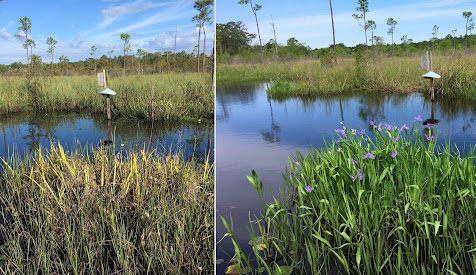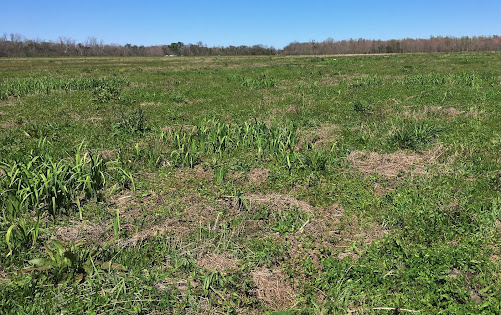By Gary Salathe
In my May 17th World of Irises posting, I wrote about the iris bloom at projects that the Louisiana Iris Conservation Initiative (LICI) had completed for the 2020–2021 fall and winter Louisiana iris planting season. We had very good bloom even though some of the locations experienced what we thought were tough conditions from Hurricane Zeta.
Hurricane Zeta hit
southeast Louisiana on October 28, 2020. The day before it made landfall, its intensity
rapidly ramped up from tropical storm to a Category 3 hurricane. The storm
moved quickly through the area, reducing the height of its storm-surge tides
and making damage in southern Louisiana less widespread. However, the intense
damage caused by the storm in areas just east of New Orleans caught everyone by
surprise.
LICI’s main function is
to relocate Louisiana irises threatened with destruction to safer areas where
the public can see them growing and blooming in their native habitat. The best
locations have raised boardwalks that allow the public to walk above a swamp or
marsh to safely experience the habitat. These are typically in area wildlife
refuges and public nature parks.
The damage caused by Hurricane Zeta to our iris plantings at the boardwalks was very minimal, except for one location that was directly in the path of the hurricane eye-wall. We figured, “Well, you only get a direct hit from a strong hurricane once every few years, so we are likely good for a while before another one comes along.” WRONG!
On August 29, 2021,
16 years to the day that Hurricane Katrina came close to wiping southeast
Louisiana off of the map with 28-foot high storm-surge tides, Hurricane Ida
made its appearance in our area. While Hurricane Zeta and Katrina stayed on a
track to the east of New Orleans, Hurricane Ida’s center traveled to the west
of New Orleans. This put the stronger south and southeasterly winds that are
found on the east side of any hurricane directly over iris country in southeast
Louisiana.
Louisiana iris distribution and recent hurricanes in Southeastern Louisiana: Hurricane Ida's path is shown in red. The winds on the right side of every hurricane blow from the south and then the east as the storm approaches. This map shows why the high storm-surge tide was so destructive compared to other storms to a huge area of marsh and swamp that is home to the Louisiana iris species I. giganticaerulea (shown in blue). The city of New Orleans is on the south side of Lake Pontchartrain.
The reports have been
slowly coming in on the damage to the boardwalks and irises in our projects. It
seems that even though the damage to the irises has been far worse than from
Hurricane Zeta, none of the stands of irises in these projects have been
totally wiped out, as the photos below show. However, at the Town of Jean
Lafitte boardwalk, which likely experienced the worst damage, we still aren’t
sure if there are many irises left. In this location, irises are mixed in with
tall grasses in the swamp away from the boardwalk, so the irises are hard to
see.
The town of Jean Lafitte elevated boardwalk before and after volunteers from LICI and Common Ground Relief cleared off the storm debris.
Although all of this sounds like we are optimistic about the impact on the irises in our projects, we are not optimistic for the irises in the entire area of southeast Louisiana. Tens of thousands of the I.giganticaerulea species of Louisiana iris growing on floating land south of New Orleans were likely destroyed when Hurricane Ida carved off huge chunks that floated out into open salt water. The result is that we have likely just lived through an event here that has done more catastrophic damage to the wild irises of southeast Louisiana in one day than any other event that has happened in the last sixty years.
These before and after photos show just one area of floating land,
called flotant, that was broken free because of Hurricane
Ida's winds and floated away. It is likely that there were large stands of I.
giganticaerulea growing in the flotant.
This photo shows an area of flotant that has broken free and was
seen floating out into the open waters of Barataria Bay. It had been established
for so long that trees had rooted in and grown on it.
The eye of Hurricane Ida passed directly over the town of Lockport's elevated boardwalk, which is the site of one of LICI's restoration projects. LICI's local volunteer, Mike Glaspell, headed up the effort to clean off and repair the boardwalk. The irises survived the storm and are doing well.
The irises in our Big Branch National Wildlife Refuge project have
survived the hurricane, but are struggling with a naturally occurring fungus
called "rust". The picture on the right was taken in April.
The picture on the right was taken in April.
The irises in our Bayou Sauvage National Wildlife
Refuge project have survived the hurricane, but are struggling after dealing with high
water from the heavy rains this year. The water level was finally dropping when
the rains from Hurricane Ida raised it up again. The picture on the right was
taken in April.
The area shown above is part of a LICI iris
restoration project in Fontainebleau State Park. It was totally submerged by 3
feet of water from the storm-surge tide of Hurricane Ida. Being under water
actually protected the irises from the wind and waves. All of the irises appear
to have survived. The picture on the right was taken in April.
Hurricane Ida's high tides impacted the Joyce
Wildlife Refuge boardwalk, a location for one of our most successful iris
restoration projects. Most of the irises that were growing in the semi-liquid
swamp muck have disappeared. We are hopeful that they were just pushed further
back into the swamp and will reestablish themselves there. The irises that were
growing on the flotant did well. They likely floated up with the storm-surge
and settled back down intact once the tide went out. The photo on the left was
taken in April. The same area is shown on the right one week after the storm. A
recent visitor to the boardwalk told us the irises are starting to peek up from
under the debris at that spot.
There are still a few
areas where we have projects that we have not been able to visit yet due to
their still needing to be cleared of debris. Like everyone else in southeast
Louisiana, we will pick ourselves up and carry on with our work. We are all
motivated by our love for Louisiana and a desire to do our small part in
preserving the plants and habitat that makes this state so special.
The Louisiana Iris
Conservation Initiative website can be found here: https://www.licisaveirises.com/
Recent articles about
our work can be found here: https://www.licisaveirises.com/news
Our Facebook page can be
found here: https://www.facebook.com/licisaveirises/
Our email address is:
licisaveirises@gmail.com




















